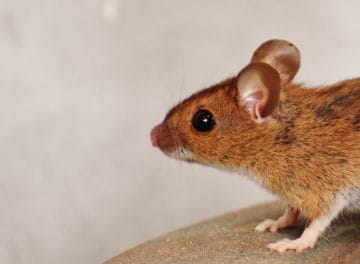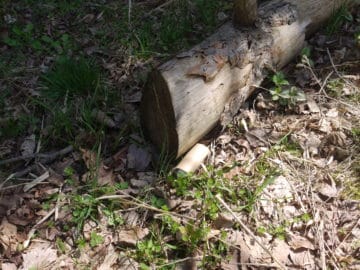UPDATE: I no longer recommend making your own tick tubes. Dan Wixted and Joellen Lampman from Cornell Cooperative Extension were kind enough to write up a detailed explanation of why this isn’t advisable:
Don’t Make Your Own Tick Tubes
Dan Wixted, Cornell University Pesticide Management Education Program
Joellen Lampman, New York State Integrated Pest Management Program
Commercially available “tick tubes” are tubes filled with permethrin-infused cotton. Mice take the cotton to line their nests and are treated for ticks every time they return home. It’s estimated that a typical ¼ acre yard needs six tubes twice a year, with a 12 pack costing ~$45 at big box stores. Although this cost isn’t excessive, there are many videos and articles on making DIY tick tubes to help people save money. But what is the actual cost?
3 Reasons Why Making Your Own Tick Tubes is a Bad Idea:
1) They probably won’t work. A pesticide product contains inert ingredients that help the active ingredient (in this case, permethrin) perform properly for the uses listed on the product label. The formulation used in commercially available tick tubes is uniquely suited for controlling ticks on mice. Other permethrin formulations are designed for other uses which are specifically listed on the label.
2) You could be putting yourself, others, pets, nontarget animals, and the environment at unacceptable risk. The EPA will register the use of a pesticide only if rigorous safety testing shows it will “pose no unreasonable risks to people or the environment when used according to label directions.” Only those uses listed on a pesticide label have met this standard, and making your own tick tubes is NOT a use listed on the label of any permethrin product. One potential risk: Permethrin is highly toxic to bees. Bumble bees often nest in abandoned mouse burrows, so making your own tick tubes could harm these important wild pollinators.
3) It is against the law. Because of Reason #2, the first sentence in the Directions for Use section of all permethrin products is “It is a violation of federal law to use this product in a manner inconsistent with its labeling.” Which, by the way, also means it is against your state’s laws.
Commercially available tick tubes cost more because it takes time and money to develop the right mix of ingredients and conduct the required safety testing to ensure that the product will control ticks without putting people, pollinators, and the environment at risk. DIY tick tubes that pose greater risks while providing poorer control of ticks are hardly a bargain; be sure to use the real thing.
For information on reducing your risk of tick-borne diseases, visit www.dontgettickedny.org.
HERE IS SOME OF THE ORIGINAL POST, FOR BACKGROUND INFO:
A tick can make you sick
I’m generally a peaceful person. I wouldn’t hurt a fly. In fact, I’ll gently capture spiders and take them outside. I’ll lovingly guide an errant bee out the window. But ticks – those little bloodsuckers bring out the warrior in me!
So small they’re nearly invisible, they threaten to ruin the outdoors for me. Every time we’re in the garden or hiking in the forest, I worry that they’ll hitch a ride, snack on us, and leave us with hard-to-diagnose and difficult-to-treat Lyme disease, which may not show symptoms until years later.
Here in the Finger Lakes, blacklegged ticks (aka deer ticks) are the biggest problem. They’re pretty much everywhere in the northeastern, mid-Atlantic, and north-central United States. Even living in the city doesn’t mean you’re safe.
Lest you think you’re in the clear in other parts of the world, I’m sorry to be the bearer of bad news: In Europe, for example, various species of ticks are also transmitting such diseases as tick-borne encephalitis and Lyme.
Fight ticks with tick tubes
We do the best we can to protect ourselves from bites by following tick protocol. And part of our defensive strategy is setting up a fortress against ticks around our yard – with tick tubes. They’re simple cardboard tubes stuffed with cotton soaked in the insecticide permethrin.
Here’s how they work: Mice are actually the primary host for blacklegged ticks, not deer. They can have as many as 100 ticks attached to their ears and faces. Ugh, I shiver just imagining that. But that also means we can use them as little tick-killers.

That’s why it’s best to place the tubes outside to coincide with certain stages of the tick life cycle and when they will feed on the mice. This will vary by region, so ask around, for example at your Cooperative Extension office.
In the northeast, the best times are sometime between May and June and again in the late summer, around August to September.
Used properly, tick tubes can reduce the risk of exposure to an infected tick by up to 97 percent on a treated property, according to a manufacturer of commercial tick tubes.
You can buy pre-made tick tubes in stores and online. The main brands are Damminix and Thermacell.
[…REMOVED INFO ABOUT MAKING TICK TUBES…]
Place your tick tubes
Walk around the perimeter of your treatment area, within about 1 yard (1 meter) of any lawn, and place the tick tubes no farther than 10 yards apart. I aim for about 10 to 15 feet (3 to 4.5 meters) distance between tubes.
You’ll want to tuck them into mouse-friendly areas, such as leaf litter, hedges, woodpiles, foundations, walls, tall grass, and under fallen tree stumps. Make sure the mice can get into the ends of the tube. (I monitored mouse tracks in the snow during the winter and will be treating the flower beds right next to our house, too.)

If you want to be especially thorough, you can check your tubes after a few weeks. Move any that are completely untouched and see if mice take you up on the offer of free nesting material at a different site.
You don’t have to collect the empty rolls later in the season, unless they’re an eyesore. They’ll break down on their own over time.
Enjoy your yard!
So there you have it. Armed with new knowledge you can go into battle against the ticks.
I’d never skip the daily tick check, but it’s nice to feel a little safer being outside in our yard with kids, pets, and visitors.
Let me know in the comments how it goes or if you have any questions!
For more practical and affordable tips for your simply happy life, sign up for our newsletter!
Photo Credits: Aaron Burden/CC0, Pixaby/CC0



 Seeking Calm? Reset Your Day in under 5 Minutes
Seeking Calm? Reset Your Day in under 5 Minutes
Love this! I’m always worried about ticks in our backyard getting on our dogs and Infant son. This will add a piece of mind.
Good luck! I hope the tick tubes do their job. At the very least they make me feel less helpless and like I’m fighting back.
Awesome. I was always looking for a step by step article on this topic. Looks like I have to save some toilet paper rolls…
You can always ask around. You’d be surprised how many people save them up for crafts or other purposes and are happy to share. That’s how I got mine the first time around.
Wow, this is an awesome tip, luckily we don’t have a lot of ticks, but we battle with fleas over here in my garden… Thank you will keep this for future use, definitely!
Good luck battling those fleas! Permethrin will definitely work on them, too.
Thank you for putting this together!! Perfect timing, I just got my permethrin in the mail and was fretting that it was too late. Great tips!
Let me know how it goes! Good luck.
Any update on the effect it has on cats if they catch/eat the mice? We have many neighborhood cats that enjoy our yard…
Thank you!
I did some more digging, and this is what I found: https://www.gardensalive.com/product/ticks. It sounds like the exposure is likely too low to be harmful. I updated the post accordingly.
Update to the update: I also received an email back from the maker of the commercial tick tubes. They said much the same thing and supported it with the following explanation: The tick tubes use permethrin that’s dry and bound to the cotton and doesn’t get released until it gets in contact with the oils on the mouse’s fur. Much less than the original 7.4% of the agent would be left by the time a cat encounters the mouse. Compare that to tick spot treatment for dogs that is 44% concentrated and is considered safe for cats to be around (on the dog) after 24 hours. They believe that permethrin from tick tubes on mice is a comparatively small danger for cats, considering other dangers they may encounter outdoors.
I’m still wavering about whether or not to use the tick tubes. We have lots of Eastern cottontail rabbits in the yard and they are always loaded with ticks (not sure what kind)…maybe fleas as well. I know there are mice around too. Cedar oil causes liver damage in rabbits, so that’s out of the question. I was also concerned about the effects of even a small amount of permethrin on cats (a neighbor’s cat often wanders into our yard), but now I’m also concerned about bumblebees as they are known to use abandoned mice nests. So, if they use a mouse nest containing the treated nesting material… 😰 I may try beneficial nematodes; even though they probably aren’t as effect as permethrin, I don’t think they pose any danger to the environment, wildlife, or pollinators.
It feels like you can’t win, right? My husband is working on me to get chickens, because they do help with ticks…
an acceptable use of permethrin is to control ticks and fleas in the yard, so that should cover the use in tick tubes
I think the issue is that while permethrin may be applied out in the yard, this particular use in tick tubes is not one of the approved methods listed on the label.
I appreciate your update re: protecting the bees. Bummed about what seems an easy and affordable way to fight the bloodsuckers that inevitably latch onto our cats, though.
I was bummed, too…Covering our yard in purchased tick tubes isn’t in our budget.